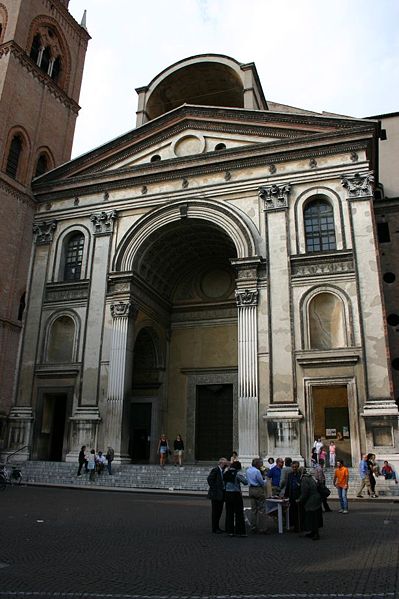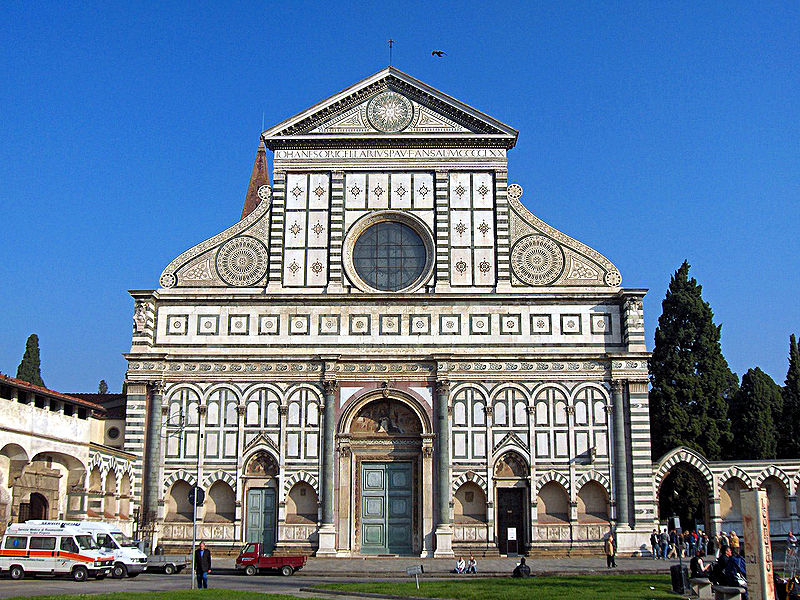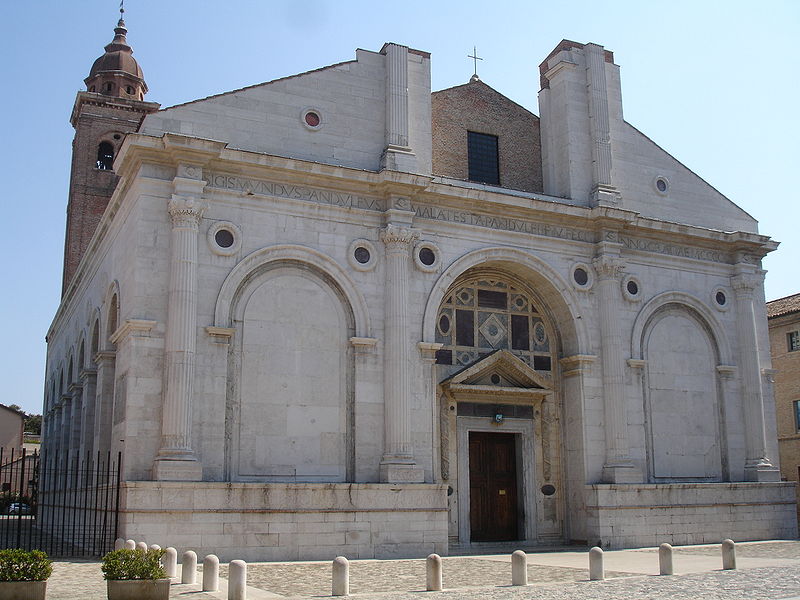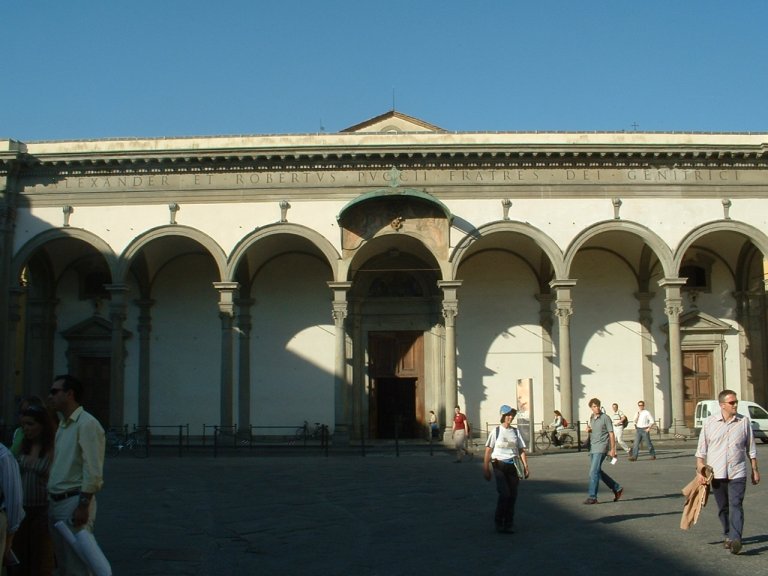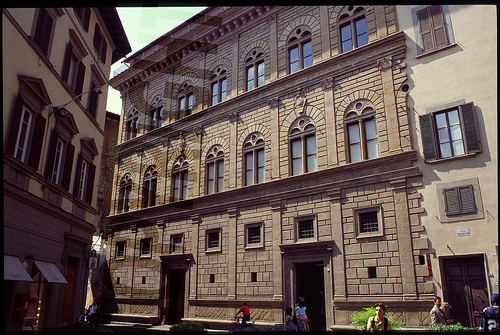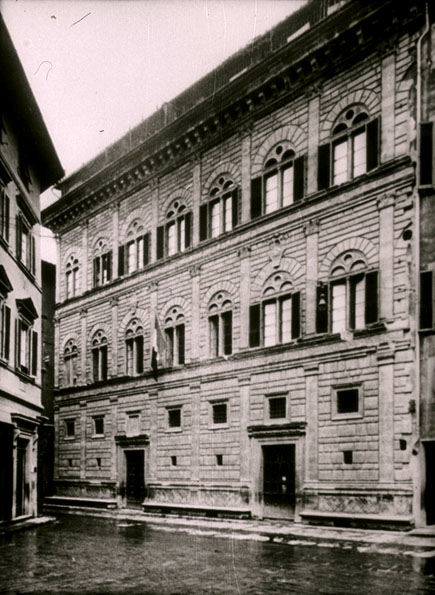<Back to Index>
- Architect and Polymath Leon Battista Alberti, 1404
PAGE SPONSOR
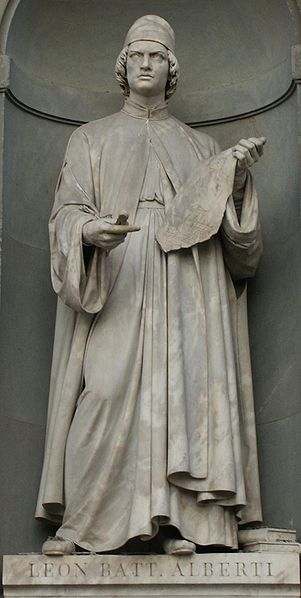
Leon Battista Alberti (February 18, 1404 – April 20, 1472) was an Italian author, artist, architect, poet, priest, linguist, philosopher, and cryptographer, and general Renaissance humanist polymath: though he is often characterized as "architect" James Beck observes, "to single out one of Leon Battista's 'fields' over others as somehow functionally independent and self - sufficient is of no help at all to any effort to characterize Alberti's extensive explorations in the fine arts." Alberti's life was described in Giorgio Vasari's Vite de' più eccellenti pittori, scultori, e architettori or 'Lives of the most excellent painters, sculptors and architects'.
An Italian humanist, Alberti is often seen as a model of the Renaissance "universal man". He was born in Genoa, one of two illegitimate sons of a wealthy Florentine merchant, Lorenzo Alberti. Leon Battista's mother, Bianca Fieschi, was a Bolognese widow who died during an outbreak of bubonic plague. Like many other families, the Albertis had been expelled from their native city, Florence, by the republican government, run by the Albizzis. At the time of Leon Battista's birth, his father Lorenzo lived in Genoa, but the family soon moved to Venice, where Lorenzo ran the family bank with his brother. Lorenzo married again in 1408. The ban on the family was lifted in 1428, and that same year Leon visited Florence for the first time.
Alberti received the best education then available to an Italian nobleman. From around 1414 to 1418 he studied classics at the famous school of Gasparino Barzizza in Padua. He then completed his education at the University of Bologna, where he studied law. In his youth, according to stories, Alberti could — with his feet together — jump over a man's head, he was a superb horseman, and he "learned music without a master, and yet his compositions were admired by professional judges."
After the death of his father, Alberti was supported by his uncles. In his twenties Alberti wrote On the Advantages and Disadvantages of Letters, which he dedicated to his brother Carlo, also a scholar and writer. Alberti's Latin comedy, Philodoxus, aimed
to teach that "a man dedicated to study and hard work can attain glory,
just as well as a rich and fortunate man." For a short time it was
passed as a genuinely antique Roman play. Like Petrarch, who had been the first famous philologist to
study the works of the ancient Roman poets, Alberti loved classics, but
he compared continual reading and rereading in libraries. Later he also
complained, that "the learned don't become rich, or if they do become
rich from literary pursuits, the sources of their wealth are shameful."
Other early works, Amator (ca. 1429), Ecatonfilea (ca. 1429), and Deiphira (ca. 1429 - 1434), dealt with love, virtues, and failed relationships.
Alberti regarded mathematics as the common ground of art and the sciences. "To make clear my exposition in writing this brief commentary on painting," Alberti began his treatise, Della pittura (On Painting), "I will take first from the mathematicians those things with which my subject is concerned."
This treatise (Della pittura) was also known in Latin as De Pictura, and it relied in its scientific content on classical optics in determining perspective as a geometric instrument of artistic and architectural representation. Alberti was well versed in the sciences of his age. His knowledge of optics was connected to the handed down long standing tradition of the Kitab al-manazir (The Optics; De aspectibus) of the Arab polymath Alhazen (Ibn al-Haytham, d. ca. 1041), which was mediated by Franciscan optical workshops of the 13th century Perspectivae traditions of scholars such as Roger Bacon, John Peckham and Witelo (similar influences are also traceable in the third commentary of Lorenzo Ghiberti, Commentario terzo).
In both Della pittura and De statua, a short treatise on sculpture, Alberti stressed that "all steps of learning should be sought from nature." The ultimate aim of an artist is to imitate nature. Painters and sculptors strive "through by different skills, at the same goal, namely that as nearly as possible the work they have undertaken shall appear to the observer to be similar to the real objects of nature." However, Alberti did not mean that artists should imitate nature objectively, as it is, but the artist should be especially attentive to beauty, "for in painting beauty is as pleasing as it is necessary." The work of art is, according to Alberti, so constructed that it is impossible to take anything away from it or add anything to it, without impairing the beauty of the whole. Beauty was for Alberti "the harmony of all parts in relation to one another," and subsequently "this concord is realized in a particular number, proportion, and arrangement demanded by harmony." Alberti's thoughts on harmony were not new — they could be traced back to Pythagoras — but he set them in a fresh context, which fit in well with the contemporary aesthetic discourse.
In Rome, Alberti had plenty of time to study its ancient sites, ruins, and objects. His detailed observations, included in his De Re Aedificatoria (1452, Ten Books of Architecture), were patterned after the De architectura by the Roman architect and engineer Vitruvius (fl. 46 - 30 B.C.). The work was the first architectural treatise of the Renaissance. It covered a wide range of subjects, from history to town planning, and engineering to the philosophy of beauty. De re aedificatoria, a large and expensive book, was not fully published until 1485, after which it became a major reference for architects. However, the book was written "not only for craftsmen but also for anyone interested in the noble arts," as Alberti put it. Originally published in Latin, the first Italian edition came out in 1546. and the standard Italian edition by Cosimo Bartoli was published in 1550. Pope Nicholas V, to whom Alberti dedicated the whole work, dreamed of rebuilding the city of Rome, but he managed to realize only a fragment of his visionary plans. Through his book, Alberti opened up his theories and ideals of the Florentine Renaissance to architects, scholars and others.
Alberti wrote I Libri della famiglia — which
discussed education, marriage, household management, and money — in the
Tuscan dialect. The work was not printed until 1843. Like Erasmus decades
later, Alberti stressed the need for a reform in education. He noted
that "the care of very young children is women's work, for nurses or
the mother," and that at the earliest possible age children should be
taught the alphabet. With
great hopes, he gave the work to his family to read, but in his
autobiography Alberti confesses that "he could hardly avoid feeling
rage, moreover, when he saw some of his relatives openly ridiculing
both the whole work and the author's futile enterprise along it." Momus, written between 1443 and 1450, was a misogynist comedy about the Olympian gods. It has been considered as a roman à clef — Jupiter has been identified in some sources as Pope Eugenius IV and Pope Nicholas V. Alberti borrowed many of its characters from Lucian,
one of his favorite Greek writers. The name of its hero, Momus, refers
to the Greek word for blame or criticism. After being expelled from
heaven, Momus, the god of mockery, is eventually castrated. Jupiter and
the other gods come down to earth also, but they return to heaven after
Jupiter breaks his nose in a great storm.
For the Rucellai family in Florence Alberti designed several buildings, the façade of Palazzo Rucellai, executed by Bernardo Rosselino, the façade of Santa Maria Novella, the marble clad shrine of the Holy Sepulchre, and perhaps also the Capella Rucellai.
The following is a list of some of his works. Some dates vary from source to source; these come from Franco Borsi, Leon Battista Alberti (1977): S. Francesco, Tempio Malatestiano, Rimini (1447,1453 - 60); Façade of Palazzo Rucellai (1446 – 51); Completion of the facade of Santa Maria Novella, Florence (1448 – 70); San Sebastiano, Mantua (begun 1458); Pienza, possibly as consultant (1459 – 62); Sepolcro Rucellai in San Pancrazio (1467); Tribune for Santissima Annunziata, Florence (1470, completed with alterations, 1477); Sant' Andrea, Mantua (begun 1471).
Among Alberti's smaller studies, pioneering in their field, were a treatise in cryptography, De componendis cifris, and the first Italian grammar. With the Florentine cosmographer Paolo Toscanelli he collaborated in astronomy, a close science to geography at that time, and produced a small Latin work on geography, Descriptio urbis Romae (The Panorama of the City of Rome). Just a few years before his death, Alberti completed De iciarchia (On Ruling the Household), a dialogue about Florence during the Medici rule. Alberti died on April 25, 1472 in Rome.
As an artist, Alberti distinguished himself from the ordinary craftsman, educated in workshops. He was a humanist, and part of the rapidly expanding entourage of intellectuals and artisans supported by the courts of the princes and lords of the time. Alberti, as a member of noble family and as part of the Roman curia, had special status. He was a welcomed guest at the Este court in Ferrara, and in Urbino he spent part of the hot weather season with the soldier - prince Federico III da Montefeltro. The Duke of Urbino was a shrewd military commander, who generously spent money on the patronage of art. Alberti planned to dedicate his treatise on architecture to his friend.
Giorgio Vasari, who argued that historical progress in art reached its peak in Michelangelo, emphasized Alberti's scholarly achievements, not his artistic talents: "He spent his time finding out about the world and studying the proportions of antiquities; but above all, following his natural genius, he concentrated on writing rather than on applied work." (from Lives of the Artists). Leonardo, who ironically called himself "an uneducated person" (omo senza lettere), followed Alberti in the view that painting is science. However, as a scientist Leonardo was more empirical than Alberti, who was a theorist and did not have similar interest in practice. Alberti believed in ideal beauty, but Leonardo filled his notebooks with observations on human proportions, page after page, ending with the famous drawing on the Vitruvian man, a human figure related to a square and a circle.
"We painters," said Alberti in On Painting, but as a painter, or sculptor, Alberti was a dilettante. "In painting Alberti achieved nothing of any great importance or beauty," wrote Vasari. "The very few paintings of his that are extant are far from perfect, but this is not surprising since he devoted himself more to his studies than to draughtsmanship." Jacob Burckhardt portrayed Alberti in The Civilization of the Renaissance in Italy as a truly universal genius. "And Leonardo da Vinci was to Alberti as the finisher to the beginner, as the master to the dilettante. Would only that Vasari's work were here supplemented by a description like that of Alberti! The colossal outlines of Leonardo's nature can never be more than dimly and distantly conceived." Burckhardt also mentions Alberti's love for animals. He had a pet dog, a mongrel, for whom he wrote a panegyric, Canis).
Alberti is said to be in Mantegna's great frescoes in the Camera degli Sposi, the older man dressed in dark red clothes, who whispers in the ear of Ludovico Gonzaga, the ruler of Mantua. In
Alberti's self - portrait, a large plaquette, he is clothed as a Roman.
To the left of his profile is a winged eye. On the reverse side is the
question, Quid tum? (what then), taken from Virgil's Eclogues: "So what, if Amyntas is dark? (quid tum si fuscus Amyntas?) Violets are black, and hyacinths are black."
Alberti made a variety of contributions to several fields:
- Alberti was the creator of a theory called "historia". In his treatise De pictura (1435) he explains the theory, of the accumulation of people, animals, and buildings, which create harmony amongst each other, and "hold the eye of the learned and unlearned spectator for a long while with a certain sense of pleasure and emotion". De pictura ("On Painting") contained the first scientific study of perspective. An Italian translation of De pictura (Della pittura) was published in 1436, one year after the original Latin version and addressed Filippo Brunelleschi in the preface. The Latin version had been dedicated to Alberti's humanist patron, Gianfrancesco Gonzaga of Mantua. He also wrote works on sculpture, De Statua.
- Alberti used his artistic treatises to propound a new humanistic theory of art. He drew on his contacts with early Quattrocento artists such as Brunelleschi and Masaccio to provide a practical handbook for the renaissance artist.
- Alberti wrote an influential work on architecture, De Re Aedificatoria, which by the 18th century had been translated into Italian, French, Spanish and English. An English translation was by Giacomo Leoni in the early 18th century. Newer translations are now available.
- Whilst Alberti's treatises on painting and architecture have been hailed as the founding texts of a new form of art, breaking from the gothic past, it is impossible to know the extent of their practical impact within his lifetime. His praise of the Calumny of Apelles led to several attempts to emulate it, including paintings by Botticelli and Signorelli. His stylistic ideals have been put into practice in the works of Mantegna, Piero della Francesca and Fra Angelico. But how far Alberti was responsible for these innovations and how far he was simply articulating the trends of the artistic movement, with which his practical experience had made him familiar, is impossible to ascertain.
- He was so skilled in Latin verse that a comedy he wrote in his twentieth year, entitled Philodoxius, would later deceive the younger Aldus Manutius, who edited and published it as the genuine work of 'Lepidus Comicus'.
- He has been credited with being the author, or alternatively the designer, of the woodcut illustrations of the Hypnerotomachia Poliphili, a strange fantasy novel.
- He took great interest in studying the ruins of classical architecture in Rome and elsewhere. At Rome he was employed by Pope Nicholas V in the restoration of the papal palace and of the restoration of the Roman aqueduct of Acqua Vergine, which debouched into a simple basin designed by Alberti, which was swept away later by the Baroque Trevi Fountain. At Mantua he designed the church of Sant' Andrea, and at Rimini the church of San Francesco. On a commission from the Rucellai family he completed the principal facade of the church of Santa Maria Novella in Florence which had been begun in the previous century. He also built the facade for the family palace in the Via della Vigna Nuova, known as the Palazzo Rucellai, though it is not exactly clear what his role as designer was.
- Alberti is also now thought to have had an important role in the designing of Pienza, a village that had been called Corsignano, but which was redesigned beginning around 1459. It was the birthplace of Aeneas Silvius Piccolomini, Pope Pius II, in whose employ Alberti served. Pius II wanted to use the village as a retreat but needed for it to reflect the dignity of his position. The design, which radically transformed the center of the town, included a palace for the pope, a church, a town hall and a building for the bishops who would accompany the Pope on his trips. Pienza is considered an early example of Renaissance urban planning.
- Some studies propose that the Villa Medici in Fiesole might owe its design to Alberti, not to Michelozzo, and that it then became the prototype of the Renaissance villa. Maybe also that this hilltop dwelling, commissioned by Giovanni de' Medici, Cosimo il Vecchio's second son, with its view over the city, is the very first example of a Renaissance villa: that is to say it follows the Albertian criteria for rendering a country dwelling a "villa suburbana". Under this perspective the Villa Medici in Fiesole could therefore be considered the "muse" for numerous other buildings, not only in the Florence area, which from the end of the 15th century onwards find inspiration and creative innovation here.
- Apart from his treatises on the arts, Alberti also wrote: Philodoxus ("Lover of Glory", 1424), De commodis litterarum atque incommodis ("On the Advantages and Disadvantages of Literary Studies", 1429), Intercoenales ("Table Talk", ca. 1429), Della famiglia ("On the Family", begun 1432) Vita S. Potiti ("Life of St. Potitus", 1433), De iure (On Law, 1437), Theogenius ("The Origin of the Gods", ca. 1440), Profugorium ab aerumna ("Refuge from Mental Anguish"), Momus (1450) and De Iciarchia ("On the Prince", 1468). These and other works were translated and printed in Venice by the humanist Cosimo Bartoli in 1586.
- Alberti was an accomplished cryptographer by the standard of his day, and invented the first polyalphabetic cipher which is now known as the Alberti cipher and machine - assisted encryption using his Cipher Disk. The polyalphabetic cipher was, at least in principle, for it was not properly used for several hundred years, the most significant advance in cryptography since before Julius Caesar's time. Cryptography historian David Kahn titles him the "Father of Western Cryptography", pointing to three significant advances in the field which can be attributed to Alberti: "the earliest Western exposition of cryptanalysis, the invention of polyalphabetic substitution, and the invention of enciphered code".
- According to Alberti himself, in a short autobiography written c. 1438 in Latin and in the third person, (many but not all scholars consider this work to be an autobiography) he was capable of "standing with his feet together, and springing over a man's head." The autobiography survives thanks to an 18th century transcription by Antonio Muratori. Alberti also claimed that he "excelled in all bodily exercises; could, with feet tied, leap over a standing man; could in the great cathedral, throw a coin far up to ring against the vault; amused himself by taming wild horses and climbing mountains." Needless to say, many in the Renaissance promoted themselves in various ways and Alberti's eagerness to promote his skills should be understood, to some extent, within that framework. (This advice should be followed in reading the above information, some of which originates in this so-called autobiography.)
- Alberti claimed in his "autobiography" to be an accomplished musician and organist, but there is no hard evidence to support this claim. In fact, musical posers were not uncommon in his day. He held the appointment of canon in the metropolitan church of Florence, and thus - perhaps - had the leisure to devote himself to this art, but this is only speculation. Vasari also agreed with this.
- He was also interested in the drawing of maps and worked with the astronomer, astrologer, and cartographer Paolo Toscanelli.
